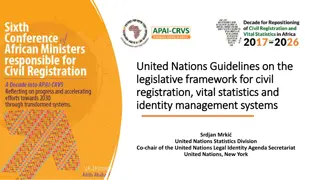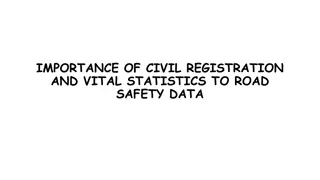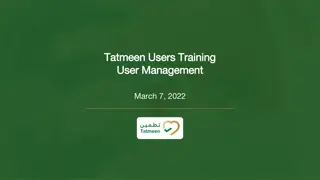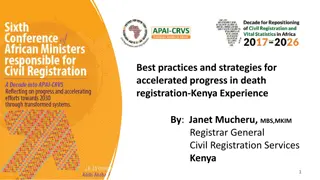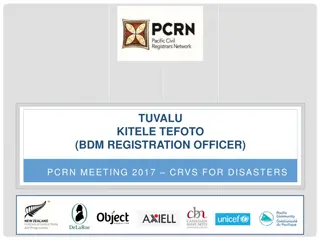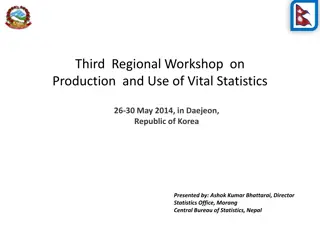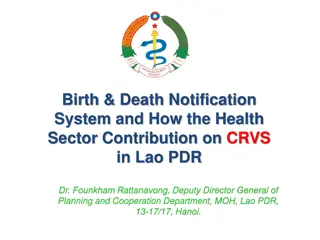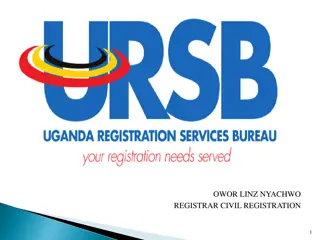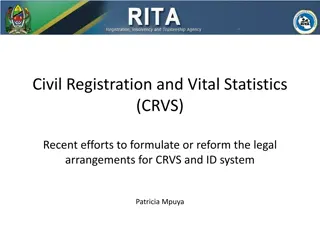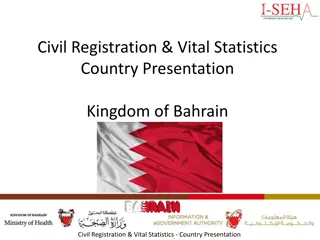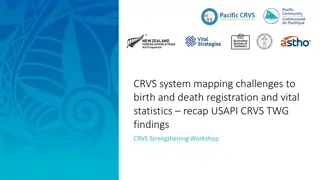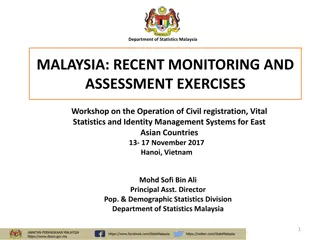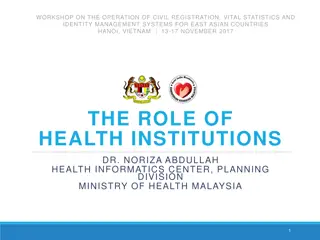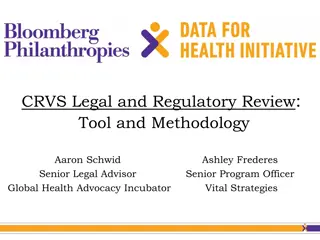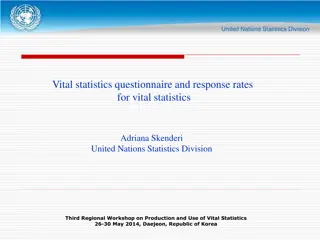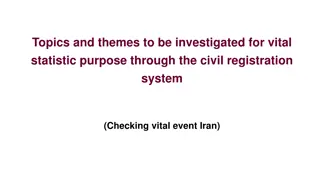Enhancing Civil Registration and Vital Statistics Systems for Sustainable Development
The report highlights the importance of political commitment, public engagement, coordination, legal frameworks, infrastructure, human resources, operational procedures, and vital statistics in improving Civil Registration and Vital Statistics (CRVS) systems. It outlines seven action areas crucial for the continuous functioning of CRVS systems and presents goals and targets for achieving universal civil registration of births, deaths, and other vital events by 2024.
Download Presentation

Please find below an Image/Link to download the presentation.
The content on the website is provided AS IS for your information and personal use only. It may not be sold, licensed, or shared on other websites without obtaining consent from the author. Download presentation by click this link. If you encounter any issues during the download, it is possible that the publisher has removed the file from their server.
E N D
Presentation Transcript
Reporting for the Mid-Term Review Fourth Meeting of the Regional Steering Group
Context: CRVS, RAF and RSG Supply Demand of CRVS For citizens For the State 2014 Ministerial Conference Ministerial Declaration CRVS Decade Regional Action Framework
7 Action Areas Political commitment Sustained political commitment is crucial for the development and continuous functioning of CRVS systems. Political commitment can galvanize all stakeholders and levels of society around efforts to improve CRVS systems, and enable CRVS improvement to be embedded into national development plans. Furthermore, political commitment is critical for ensuring that CRVS systems are adequately resourced and are designed to be inclusive and responsive. Public engagement, participation and generating demand Improving the coverage of civil registration requires individuals and families to know the value of declaring vital events to relevant authorities and to be willing to do so. Public engagement, participation and demand generation involves enhancing public awareness of the importance of declaring vital events and the value of vital statistics, and efforts to remove barriers to registration at all levels. Coordination Since there are so many institutions involved in and benefiting from CRVS, effective coordination is a prerequisite for universal and responsive CRVS systems. Coordination must take place among all relevant responsible stakeholders in countries at all levels of government, among development partners and between Governments and development partners. Policies, legislation and implementation of regulations A sound legal framework provides the basis for a universal and responsive CRVS system. Reviewing and updating of relevant legislation, regulations and policies is often a first step and common priority in a comprehensive multisectoral national CRVS strategy. It is especially important that the legal framework for CRVS does not create discriminatory barriers to civil registration. Infrastructure and resources Registration points should be within a reasonable distance for the whole population, or measures, such as mobile registration options, need to be undertaken to facilitate civil registration in remote areas on a routine basis, including for hard-to-reach and marginalized populations. In terms of human resources, CRVS systems depend on a sufficient number of qualified staff. Governments need to consider mechanisms for career development and appreciation, as well as ongoing training to enhance the skills of and retain staff. Sufficient and sustainable investments are essential to enable incremental improvements. Operational procedures, practices and innovations Attention must also be paid to ensure that legal and institutional frameworks are effectively and consistently applied through the design and implementation of operational procedures and practices. Production, dissemination and use of vital statistics The administrative data from civil registration, when universal, is the preferred source of vital statistics in terms of accuracy, completeness and timeliness. Governments may need to adopt a phased approach to using civil registration records as a source of vital statistics by ensuring that information on currently registered vital events is compiled in a way to allow the production of vital statistics.
3 Goals and 15 Targets Goal 1: Universal civil registration of births, deaths and other vital events 1.A. By 2024, at least per cent of births in the territory and jurisdiction in the given year are registered. 1.B. By 2024, at least per cent of children under 5 years old in the territory and jurisdiction have had their birth registered. 1.C. By 2024, at least per cent of all individuals in the territory and jurisdiction have had their birth registered. Goal 2: All individuals are provided with legal documentation of civil registration of births, deaths and other vital events, as necessary, to claim identity, civil status and ensuing rights 2.A. By 2024, at least per cent of all births registered in the territory and jurisdiction are accompanied with the issuance of an official birth certificate that includes, as a minimum, the individual s name, sex, date and place of birth, and name of parent(s) where known. 2.B. By 2024, at least per cent of all deaths registered in the territory and jurisdiction in the given year are accompanied with the issuance of an official death certificate which includes, as a minimum, the deceased s name, date of death, sex, and age. Goal 3: Accurate, complete and timely vital statistics (including on causes of death) are produced based on registration records and are disseminated 3.A. By (year), annual nationally representative statistics on births disaggregated by age of mother, sex of child, geographic area and administrative subdivision are produced from registration records or other valid administrative data sources. 3.B. By (year), annual nationally representative statistics on deaths disaggregated by age, sex, cause of death defined by ICD (latest version as appropriate), geographic area and administrative subdivision are produced from registration records or other valid administrative data sources. 3.C. By 2024, at least per cent of deaths occurring in health facilities or with the attention of a medical practitioner have an underlying cause of death code derived from the medical certificate according to the standards defined by ICD (latest version as appropriate). 3.D. By 2024, the proportion of deaths coded to ill-defined codes will have been reduced by per cent compared with the baseline year.
8 Implementation Steps Establish an effective and sustainable national CRVS coordination mechanism comprising all stakeholders; Conduct a standards-based comprehensive assessment of CRVS in their territory, which is inclusive of all relevant stakeholders, for the purpose of identifying gaps and making recommendations that will be the foundation of a comprehensive multisectoral national CRVS strategy; Set the national target value for each target, in consultation with all relevant stakeholders, and report these to the ESCAP secretariat; Develop and implement a plan for monitoring and reporting on achievement of the targets, including on reporting to the ESCAP secretariat; Assess inequalities related to CRVS experienced by subgroups of the population, including among hard-to- reach and marginalized populations and particular geographic areas and administrative subdivisions, and, where appropriate, set national targets to address those inequalities; Develop and implement a comprehensive multisectoral national CRVS strategy, aligned, where appropriate, with the action areas of the regional action framework, with political commitment, adequate funding, and a clear delineation of responsibilities for stakeholders to establish accountability for the implementation; Assign a national focal point within the Government for coordinating with the ESCAP secretariat and development partners; Through the national focal point, report relevant information to the ESCAP secretariat or subregional body, in accordance with the reporting structure for the regional action framework.
Reporting Framework and Ideal Result Year Activity 2015 Members and associate members submit baseline report to the secretariat 2016 Regional baseline analysis 2019 Members and associate members submit midterm report to the secretariat 2020 Midterm regional review is conducted 2024 Members and associate members submit final report to the secretariat 2025 Final regional review conducted 2015 2020 2025 Country (Baseline) (M-T Review) (Final Review) i - - - - - - - - - - j - - - - - complemented with Qualitative Data
Principles of Guidelines and Questionnaire Many countries did not report -> Maximize number of countries reporting -> Shorter guidelines Workshops, translation, any others? Maximize data reported -> Better coordination Appointment of national focal points More interaction (workshops) Relative flexibility in time-frame Ensure high-quality data Clear guidelines with definitions of indicators Steps: Notification, Declaration, Registration Clear role of national focal points, translation* Institutional arrangements -> Quantitative and Qualitative Data
Key Roles of National Focal Points Coordination of different bodies Comprehensiveness Quality assurance Regular interaction with ESCAP and RSG Sufficient time to consult, fill out questionnaires, etc. Data endorsement
Proposed Time Frame Month Task January ESCAP will issue letters to Ministries of Foreign Affairs requesting updates/confirmation on current National CRVS Focal Points February ESCAP will issue final versions of the midterm reporting questionnaire and guidelines March ESCAP will issue the questionnaire and guidelines to the CRVS Focal Points for distribution to relevant ministries/agencies Mid-March In coordination with development partners, ESCAP may try and host workshops to deliver technical assistance on completing the questionnaires April June ESCAP will follow up with countries and continue providing assistance July 1 Submission Deadline July December ESCAP will validate data and follow up with countries ESCAP will compile the data and start preparing the outline for the Regional Synthesis Report 4. Quarter 2019 Fifth RSG meeting ESCAP will present the outline for the Regional Report to the RSG members
Group Discussions Objective: Guidance on how to pursue the 3 goals? More countries reporting Reporting of more data (including additional targets) Ensuring high-quality of data reported Guidance Questions Formatting of Questionnaire Pre-filling vs not Role of Development Partners: Facilitation of the nomination of focal points Technical support Coordination support
Thank you! Questions? For more information, please visit: www.getinthepicture.org


